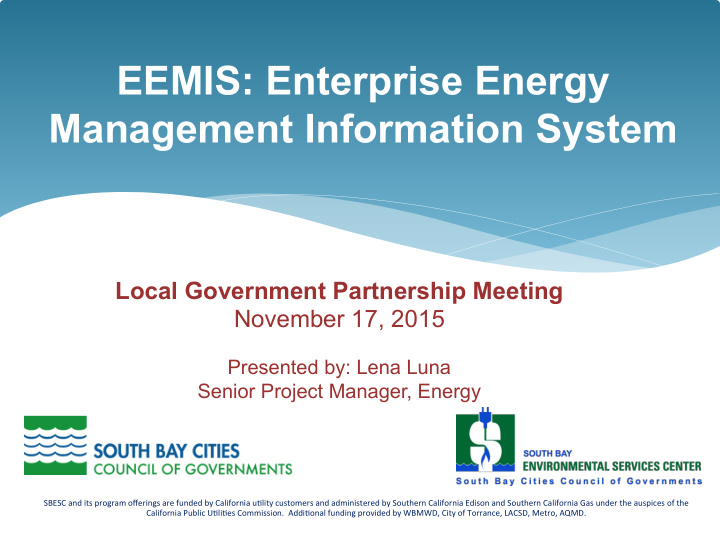



EEMIS: Enterprise Energy Management Information System Local Government Partnership Meeting November 17, 2015 Presented by: Lena Luna Senior Project Manager, Energy SBESC ¡and ¡its ¡program ¡offerings ¡are ¡funded ¡by ¡California ¡u8lity ¡customers ¡and ¡administered ¡by ¡Southern ¡California ¡Edison ¡and ¡Southern ¡California ¡Gas ¡under ¡the ¡auspices ¡of ¡the ¡ California ¡Public ¡U8li8es ¡Commission. ¡ ¡Addi8onal ¡funding ¡provided ¡by ¡WBMWD, ¡City ¡of ¡Torrance, ¡LACSD, ¡Metro, ¡AQMD.
Acknowledgments • EEMIS implementation (2011-2014) funded by CA Title ratepayers under the auspices of the California Public Utilities Commission (CPUC) through the California Energy Efficiency Strategic Plan (CAEESP) grant awarded by Southern California Edison (SCE). • Current EEMIS program (2015) funded by CA ratepayers under auspices of the CPUC; integrated into SCE/SCG Local Government partnership funding
CA Energy Efficiency Strategic Plan Funding #1 Strategic Plan menu item selected by 101 local governments partners – utility bill manager • CPUC’s long-term California Energy Efficiency Strategic Plan (CAEESP) • Local governments lead by example • Establish utility bill manager to track municipal energy usage to plan , budget , and manage • AB 32, CA Loading Order
Definition Title Enterprise Energy Management Information System A system providing information of local government’s (or organization’s) energy use, including electricity, natural gas, and other commodities.
The Problem à à The Solution One year of paper bills One year of data in EEMIS
EEMIS-Enrolled South Bay Cities Carson Lomita Title El Segundo Manhattan Beach Gardena Palos Verdes Estates Hawthorne Rancho Palos Verdes Hermosa Beach Redondo Beach Inglewood Rolling Hills Estates Lawndale Torrance
3 Questions Title 1. Where are we currently? 2. Where do we want to go? 3. How do we get there?
#1. Where are we currently? Title
#1. Where are we currently? Web-accessible utility bill manager: • Automate month-end utility bill data • Reduce city staff time searching for paper bills • Supply timely and credible energy usage and budget information • Expedite energy project development • Provide ongoing measurement and verification of energy projects • Identify opportunities for improved operation and maintenance practices
#1. Where are we currently? South Bay COG worked closely with Los Angeles County Internal Services Department (LA County ISD) to make EEMIS happen • Leveraged Los Angeles County/Energy Hippo (previously McKinstry) EEMIS – regional cost-sharing • La County ISD administering EEMIS since 2002 • Dedicated LA County ISD EEMIS team – administration and technical support
#1. Where are we currently? • Example of report to compare energy use and cost to prior fiscal year
#1. Where are we currently? • Example of benchmarking report among city ’ s facilities
#1. Where are we currently? With SBCCOG as Implementer: • Enrolled approximately 2,400 electric accounts into EEMIS with collaborative teamwork from SBCCOG, SBCCOG member cities, Los Angeles County, and SCE • Installed real-time energy monitoring at city hall for two cities with over 200 kW demand • Identified high Energy Use Intensity (EUI) buildings to prepare facility benchmark reports
#1. Where are we currently? Continued, • Provided facility performance reports to help cities establish an energy re-investment fund • Expedited Energy Action Plan preparation for two cities • Contributed to cities of Lawndale and Manhattan Beach achieving Platinum under SCE ’ s Energy Leader Partnership program through development of facility benchmarking reports • Aided in preparation of Energy Efficiency Climate Action Plans (EECAP) in 2014 - 2015
#1. Where are we currently? Finding Example 1: Finding Description FY 2013/2014 Cost #1 – Community Energy use and cost increase from prior $27,700 Center fiscal year #2 – Zero energy use City paid for no energy use electric $5,700 accounts – 21 accounts #3 – Low energy use City paid for low energy use (<50 kWh) $6,100 electric accounts – 20 accounts #4 – Tariff evaluation Possible tariff change for traffic control and ---- streetlights on TOU-GS-1 tariff #5 – Third-party City paying for electric account serving $2,100 agency third-party agency Total: $41,600
#1. Where are we currently? Findings Example 2: Finding Description FY 2013/2014 Cost #1 – Main Library Energy use and cost increase from prior $16,800 fiscal year #2 – Zero energy use City paid for no energy use electric $5,000 accounts – 15 accounts #3 – Low energy use City paid for low energy use (<50 kWh) $9,200 electric accounts – 31 accounts #4 – Tariff evaluation Possible tariff change for traffic control on ---- TOU-GS-1 tariff #5 – Private Business City paying bill with meter located on $600 building occupied by small business Total: $31,600
#2. Where do we want to go? Challenges Encountered: • Managed file transfer protocol delays • Customer authorization (“CISR” forms) • Data quality • Potential remedies – Green Button in 2016, establish quality management plan • Learning process • Common issue in enterprise energy information systems, examples can be found in other organizations
#2. Where do we want to go? • Make energy management proactive instead of reactive • Get top-management buy-in • Institutionalize EEMIS • Establish an Energy Fund in budget at each city
#3. How do we get there? CA flow-down policies in 2015 • SB 350 – doubling of energy efficiency • Executive Order B-30-15 At City Level – “Lead By Example” • City Councils make a priority • Top-management buy-in • Autonomy given to front-line city staff to be “energy managers” and have ownership of making a difference in municipal operations
Questions? Lena Luna Senior Project Manager, Municipal Energy Lena@southbaycities.org (310) 371-7222
Recommend
More recommend